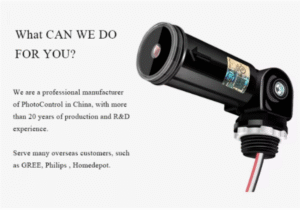Schema
- Introduzione
- Why Compatibility Matters in Street-Light Interruttori fotocellule?
- Mechanical Interface – Will the Sensore di illuminazione della fotocellula Physically Fit Your Fixture?
- Electrical Ratings – Can the Sensore di luce Handle Your Lighting Load Safely?
- Environmental Resistance – Will the Sensore fotoelettrico Survive Outdoor Conditions?
- Smart Features – Do You Need Connectivity Beyond Dusk-to-Dawn Control?
- Certifications – Will the Sensore fotocellula di luce Pass Industry and Safety Standards?
- Why Choose Shanghai Long‑Join Electronics Photocells for Guaranteed Compatibility?
- Parole finali
Are you sure the photocells you’re using actually fit your street lights?
Many installers assume all fotocontrollori work the same. But they don’t. A small mismatch in design or certification can cause big problems later. From flickering lights to issues with market entry, the wrong photocell can cost time and money.
Before placing your next order, it’s worth asking: Is your controllo dell'illuminazione truly compatible with your lighting system? Let’s find out what you should check before buying.

Why Compatibility Matters in Street-Light Interruttori fotocellule?
What role do fotocontrolli play in outdoor lighting systems? These sensors automatically switch street lights on and off. This enables effective energy savings and reduced maintenance.
However, sometimes compatibility issues arise. This is because modern luminaires vary due to multiple reasons, including
Any of these can cause a malfunction. To avoid this, it’s critical to consider the five key factors given below:
- Mechanical interface
Ensures the sensor physically fits the socket.
- Electrical ratings
Voltage and load capacity must match the luminaire.
- Environmental resistance
Outdoor durability protects the lifespan.
- Smart features
Integration with IoT or basic control must align.
- Certificazioni
Regulatory compliance gives easy market entry.
By checking these five factors, you’re far more likely to select a photocell that truly works with your lighting system. Further below is a comparison table of photocell bases.
| Standard di interfaccia | Typical Base / Socket Diameter | Configurazione dei pin | Common Application Region |
| ANSI C136.10 / ANSI C136.41 (NEMA) | 76 mm diameter | 3-pin, 5-pin, or 7-pin twist-lock | America del Nord |
| Zhaga Libro 18 | 43.5 mm / 63.2 mm / 75.3 mm | 4-pin or module interface | Europe, Asia |
| Wire-In Direct Connection | N/A (no base) | Fixed wiring (live, neutral, maybe dim) | Fixtures without a socket |
Mechanical Interface – Will the Sensore di illuminazione della fotocellula Physically Fit Your Fixture?
Quando si seleziona un photocell for street lights, the first proper check is whether the mechanical interface matches your fixture. Misfits cause wasted time, extra cost, and sometimes installation failure.
Main types of interfaces
Twist-Lock / ANSI C136.10
This is the conventional U.S. style. The photocell twists into a 3-pin or 7-pin “locking” receptacle.
Zhaga Libro 18
A newer global smart-lighting standard covering plug-and-play sensor modules.
Wire-In models
These are hard-wired directly to the luminaire wiring rather than using a receptacle base. Useful in fixtures without a socket interface.
How they differ
- Twist-Lock uses standardized pins and twist action to secure contact and alignment.
- Zhaga defines a socket module interface where sensors or controllers plug into a defined mechanical and electrical interface for smart-city use.
- Wire-In models bypass sockets entirely and directly connect to luminaire wiring — simple, but less modular and often less future-proof.
Why you must confirm compatibility
If your luminaire accepts a NEMA/ANSI-style twist-lock base but you buy a Zhaga interface, the photocell simply won’t mount. If your fixture uses a wire-in connection but you try to install a socket-mounted unit, you’ll face big installation issues. Ensuring your fixture supports the exact interface saves wasted units and downtime.

Common mechanical mismatches
- Interruttore fotocellula con sensore di luce pins don’t align with the receptacle (e.g., 3-pin vs 5/7-pin).
- The receptacle exists, but the cell’s body is too large, or the thread doesn’t match.
- Fixture uses a Zhaga socket, but a non-Zhaga cell is used — no plug-and-play.
- Wire-in fixture lacks a base entirely, so a socket-mount cell won’t physically attach.
By verifying the mechanical interface early, you avoid needless installation delays and ensure the photocell physically fits and functions as intended.
Electrical Ratings – Can the Sensore di luce Handle Your Lighting Load Safely?
When selecting controllo dell'illuminazione, verify its electrical ratings. This is essential to safe and reliable operation. Fotosensori list two primary ratings:
Compatibilità di tensione
Ensure the photocell switch’s rated voltage matches your supply. Common values include:
- 120 V
- 220–240 V
- A universal range of 105–305 V
A cell rated for any specific voltage, if used on any different supply, is vulnerable to failure.
Load and Inrush Current
Check the load rating in watts or VA. Also assess any inrush current requirements. This is especially important for LED drivers.
A light sensor switch may be rated 500 W @ 120 V or 1000 W @ 240 V. If the load is an LED driver, expect high startup currents despite low steady-state wattage.
Tipo di carico
HID ballasts impose large steady loads plus ballast losses. LED systems may draw lower steady state, but a high surge inrush. The photocell must tolerate those surges. Hybrid systems demand a photocell rated for both kinds of loads.
Consequences of Rating Mismatch
- If the voltage rating exceeds, the device may overheat or fail instantly.
- UN interruttore sensore luce under-rated for load can degrade internally or cause contact failure.
- Such failures can lead to lamp startup issues. Sometimes it can even lead to fire risk.
Always match the fotocontrollori rated voltage with your circuit supply and fixture type. This ensures safe operation and avoids premature failures.
Environmental Resistance – Will the Sensore fotoelettrico Survive Outdoor Conditions?
The durability of a controllo dell'illuminazione depends on its surrounding climate. Whether it’s about high temperatures or cold extremes, all these accelerate material degradation. To endure these elements:
- Use a polybutylene terephthalate base. This will resist heat and is flame-retardant.
- The polycarbonate dome will retain optical clarity under the sun and weather.
- Water and dust ingress are major failure modes. IP ratings are a good solution to this. They indicate the unit is protected.
- Salt spray testing verifies corrosion resistance in coastal regions.
When environmental protection is ignored, photocells often fail within months. This will eventually add up to the cost. Ensuring robust outdoor design upfront lowers long-term maintenance and improves fixture uptime.
Smart Features – Do You Need Connectivity Beyond Dusk-to-Dawn Control?
Di base presa fotocontrollata offers only on/off control based on ambient light. Smart photocells go further. They integrate wireless communication and data monitoring. Common protocols with their respective details are mentioned in the table below.
| Protocollo | Gamma tipica | Velocità dati | Miglior caso d'uso |
| ZigBee | 10-100 m (mesh) | 20-250 kbps | Urban clusters, dense fixture networks |
| LoRa / LoRaWAN | Up to 10-15 km open area | <10-100 kbps | Suburban/Highway lighting, remote zones |
| NB‑IoT | Nationwide via carrier | ~250 kbps | Large city roll-outs with telecom backing |
| Wifi | ~100 m | Fino a 150 Mbps | High-data needs (video, large network) |
With these smart features, you can:
- Remotely monitor each luminaire’s status
- Detect faults in real time
- Collect energy usage data for analytics and optimization.
For example, a LoRa-based module plugged into a NEMA socket enables cloud reporting and centralized control. Deciding whether to invest depends on your project scale and needs.
Choose standard on/off if simplicity and low cost are your priority. Opt for smart control if you’re managing large networks or plan future IoT integration. Smart photocells become strategic nodes in a connected lighting system rather than just dusk-to-dawn switches.
Certifications – Will the Sensore fotocellula di luce Pass Industry and Safety Standards?

These standards serve as a checklist of verified safety and compatibility measures. If a photocell is uncertified, the risk is not only about sub-standard performance but also about hidden reliability issues.
Key certifications for lighting controls are listed in the table below.
| Certificazione | Ente emittente | Area di interesse |
| UL 773 | Underwriters Laboratories | Electrical safety & mechanical interface for street-lighting controls |
| ANSI C136.10 / C136.41 | Illuminating Engineering Society / NEMA | Twist-lock socket and control interface standard |
| Zhaga Libro 18 | Consorzio Zhaga | Smart module socket interface (power + communication) |
| CE / RoHS | European regulatory bodies | Safety (CE) and hazardous substances (RoHS) |
| ISO series | International Organization for Standardization | Quality management, environmental standards |
How certifications affect projects
- UL O CE marks ensure product entry in North America or Europe.
- Many engineering tenders mandate specific certifications; non-compliance risks disqualification.
- Certified units are tested for load, environment, and interface compatibility, reducing premature failures and maintenance costs.
Why Choose Shanghai Long‑Join Electronics Photocells for Guaranteed Compatibility?
When your project demands true compatibility and reliability, Shanghai Long-Join Electronics positions itself as a definitive solution.
They ensure that their photocells offer a list of multiple advantages. Here are the details:
Full mechanical interface range
Includes NEMA/ANSI twist-lock (3-pin, 5-pin, 7-pin), Zhaga Book 18 end-modules, wire-in types, and shorting caps for fixtures not using a socket.
Comprehensive certifications
Products carry UL, ANSI, Zhaga, CE, Direttiva RoHS markings — giving assurance of compliance for North American, European, and smart-city tenders.
High durability and surge protection
Models such as the JL-205C series cover a broad voltage range. They also include surge arresters MOVIMENTO to protect against high transient voltages in street-lighting environments.
Smart-ready designs for IoT applications
Long-Join offers dimming and smart controller compatible modules (0-10 V, Zhaga plug-and-play sensor modules) enabling remote monitoring or integration into smart-lighting networks.
OEM/ODM customization for project-specific needs
They support customized housing, branding, and specialized functions (voltage range, interface type, smart connectivity), making them adaptable to lighting OEMs and large-scale EPC projects.
Parole finali
Reliable photocells depend on durability and verified certification. Long-Join products meet these standards. They ensure consistent performance in every lighting project. For sourcing genuine Long-Join photocontrollers, Chi-Swear stands out as a trusted supplier. They offer certified products with dependable after-sales support for long-term reliability.
Link esterni
- https://www.nema.org/
- https://www.zhagastandard.org/index.php?option=com_content&view=article&id=340:zhaga-enables-iot-upgradeable-outdoor-led-lighting-fixtures&catid=22
- https://en.wikipedia.org/wiki/LoRa
- https://www.ul.com/solutions
- https://en.wikipedia.org/wiki/CE_marking
- https://en.wikipedia.org/wiki/RoHS
- https://en.wikipedia.org/wiki/Varistor
- https://en.wikipedia.org/wiki/0-10_V_lighting_control






